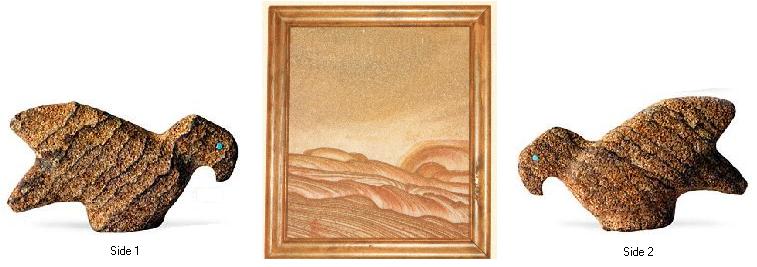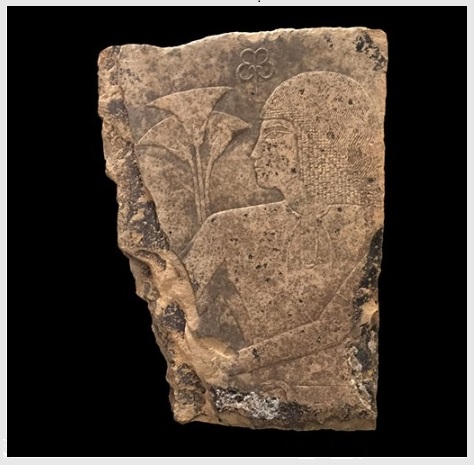( Fr- grès; Ger- Sandstein;
Nor- sandstein; Rus- ![]() )
)
SANDSTONE

A (left) & C (right). Sandstone. Eagle fetish (width
~ 6 cm) with
turquoise eyes by Jeffrey
Tsalabutie. (©
photo by Light Language Photo Studio, courtesy www.zunifetishesdirect.com)
B (center). Sandstone. Scenic
sandstone
marketed as Kanab Wonderstone (height - 24.2 cm) from Kanab,
Utah. R.V.
Dietrich collection. (© photo by Dick Dietrich)

DESCRIPTION: Sandstone is sand that has been lithified (i.e.,
turned to rock). Most sand grains of most sandstones are
quartz, the properties of which are given in the GRANITE entry;
the cement, which so-to-speak holds the grains
together, may be such
minerals as calcite or quartz.
Colors - commonly white, off-white, gray,
reddish, mauve, tan to rust-brown, commonly mottled,
laminated, etc.
H. (effective) 7
S.G. 2.0-2.65
Light transmission - opaque with thin pieces
of some specimens translucent
Luster - dull to subvitreous
Breakage - irregular to subconchoidal.
OTHER NAMES: Sandstone units are referred to in geologic literature and on geologic maps by formal stratigraphic unit names (see Appendix B, Glossary). -- Two well known examples are the Potsdam Sandstone of northern New York, Vermont and nearby Ontario, Canada; and the Coconino Sandstone of Arizona, Utah and Nevada.
USES: The most common uses of sandstones as decorative stones is placing those like the one illustrated by Figure B in frames for wall hangings. Similar sandstones have been shaped to use as bookends, candle holders, clocks, paperweights, coasters (and for this use frequently have been impregnated); some of these sandstones have had "artwork" etched into, painted on, or otherwise added to their surfaces -- see, for example, Spendlove (1979). Pieces of flagstone with bland surfical characteristics have been engraved with diverse "artwork" and/or words for marketing, particularly as so-to-speak inspirational pieces. A few sandstones have been carved into such things as fetishes (see Figs. A & C), and a "huge, old bust of Buddha ... [sculpted from] slightly calcareous sandstone" has been recorded by Liddicoat (1963-64, p.118). More recently, some small interesting "'Sandstone Arches 'carved' from natural sandstone with wind and water to imitate the famous red rock arches found in Utah." have been advertized and illustrated on the internet.(www.saltlaketogo.com)
OCCURRENCES: Typically in lithified sedimentary sequences consisting wholly or in part of near-shore deposits of clastic fragments.
NOTEWORTHY LOCALITIES: In addition to localities mentioned under the OTHER NAMES subheading, the Potsdam Sandstone of northwestern New York and southern Ontario is one of the flagstones that has been engraved as noted under the USES subheading. Also, an opal-cemented quartz sand, with sporadic pyrite grains, from near Lafayette, Louisiana has been cut and polished as cabochons.
REMARKS: The name sandstone is, of course, based on the fact that this rock is made up largely of sand grains."Shaman Stones" -- also called "Moqui marbles"
and "Thunderballs" -- from southern Utah have been used as talismans
and toys for untold centuries and more recently also sold as souvenirs.
Though chiefly sandstone, these spheroidal masses, most of which range
between 1 and 8 centimeters in diameter, seem best described as
concretions with sandstone centers and hematite-rich shells.
Discoveries in archaeological excavations indicate that shamans
(shamen?) used these "stones" well before Leif Eriksson landed in North
America; and, today, some people continue to attribute diverse
healing and metaphysical properties to these stones. The Moquis, by the
way, are generally considered to be ancestors of the Hopis.
Potsdam
Sandstone flagstones served as the
sidewalks in Hammond, Saint
Lawrence County,
New York (my hometown) until most of them were replaced by concrete
during the 1930s, 1940s and 1950s. We "kids" especially enjoyed
roller skating
on the slabs, with ripple mark surfaces -- they emitted rat-ta-tat,
machine gun-like, sounds as we skated over them.
SIMULANTS:
*** "Cast in sandstone" is a description given
replicas of two sculptures -- one of the Indian Maiden (Nakoma)
and girl holding bowls, the other of an Indian warrior (Nakomis) and
boy holding arrows and girl holdof Frank Lloyd Wright's --
advertized in a recent specialty house catalogue. - [I suspect
that the binding material for this apparently predominantly sand
material is either a resin or cement, either of which would be
relatively determined not to be natural cementing material; in
addition, the cast (versus sculpted) characteristic should be easily
recognized.]
***CoasterStone (a trademark) - a resin cemented-sand that is marketed with several different designs, including some that closely resemble scenic sandstones - [may require non-macroscopic means].
***Porcelain called Sandstone - bowls, for example, of this porcelain are marketed. My impression, however, is that the name is not meant to indicate their composition or to suggest that they are made of sandstone. Instead, it appears to be meant to indicate their color. - [Visual inspection should suffice and porcelain has an inferior hardness.].
REFERENCES: No general reference.
R. V. Dietrich © 2016
Last
update: 10 March 2016
web page created by Emmett Mason